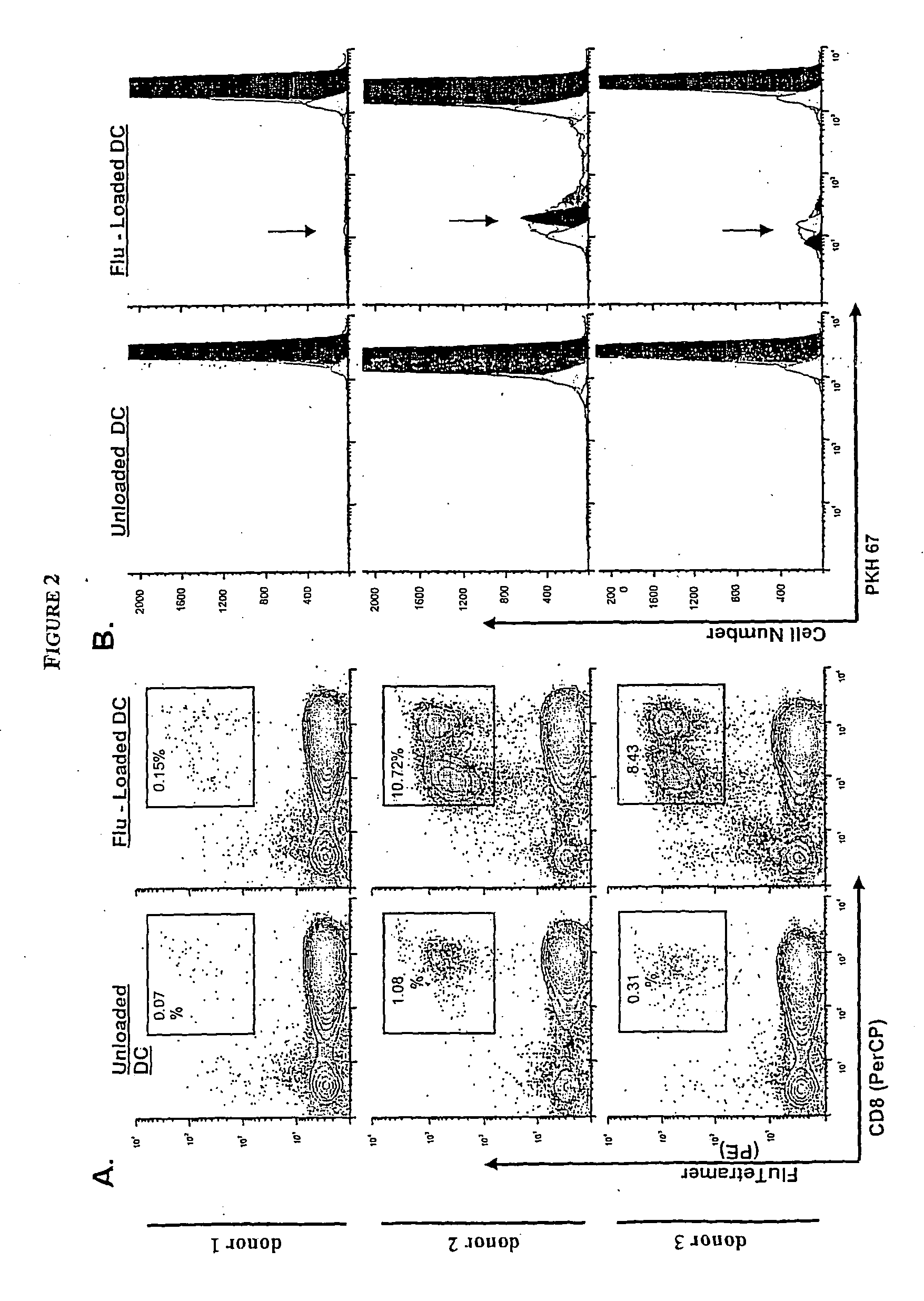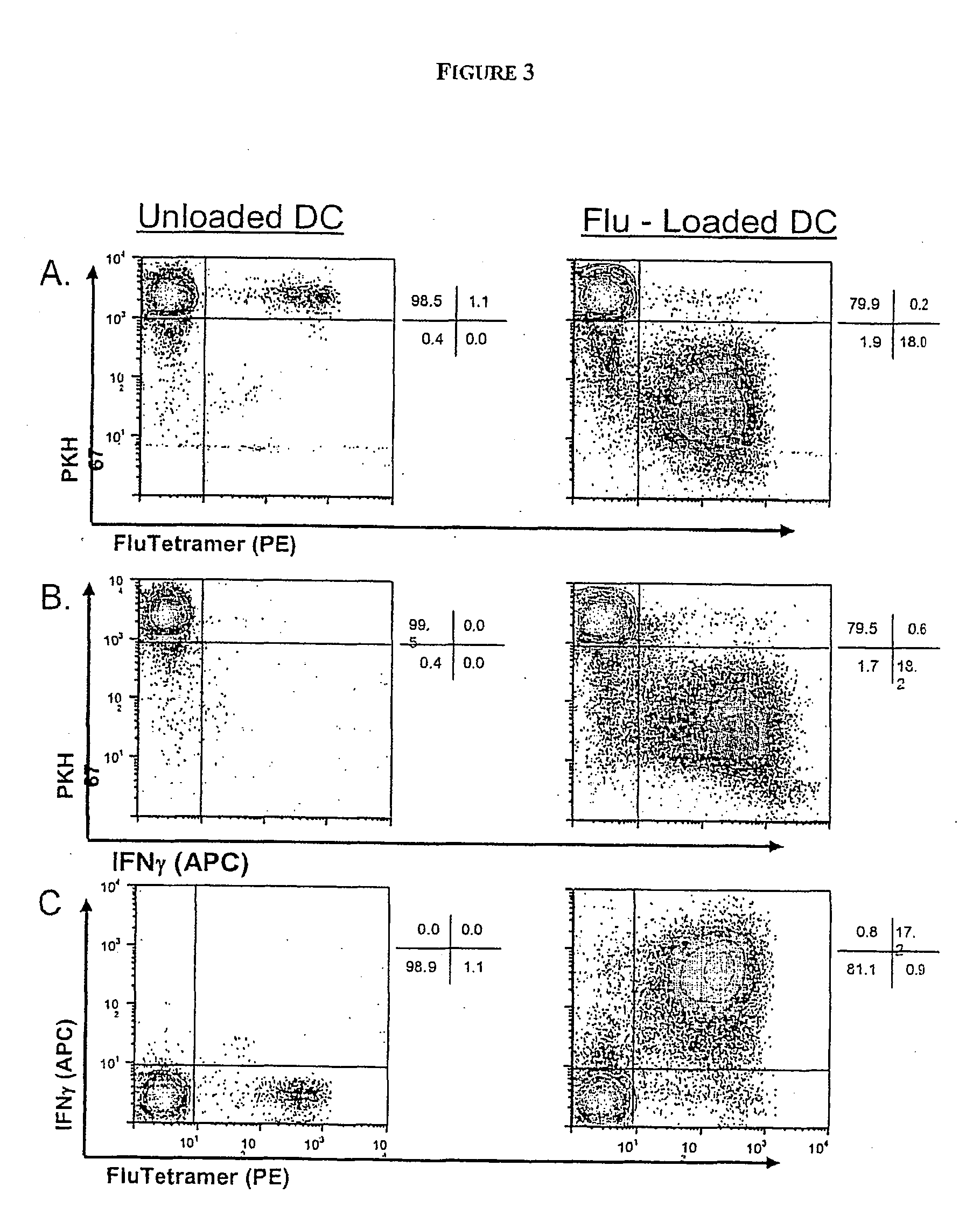Method to measure a t cell response and its uses to qualify antigen-presenting cells
a t cell response and antigen-presenting cell technology, applied in the field of t cell response measurement and its use to qualify antigen-presenting cells, can solve the problems of naive or experienced, difficult to describe the response to this antigen quantitatively, and difficulty in evaluating the repertoire of t cells, etc., to achieve the effect of measuring the effectiveness of complex cross-talk and increasing sensitivity
- Summary
- Abstract
- Description
- Claims
- Application Information
AI Technical Summary
Benefits of technology
Problems solved by technology
Method used
Image
Examples
example 1
[0272] Here we illustrate the method according to the invention, based on multiparameter flow cytometry, to visualize simultaneously proliferation and cytokine production by T cells having different capacities to bind MHC / peptide tetramers; this method also allows calculations of the original frequency of these sub-populations of cells ex vivo.
[0273] Antigens encountered by T cells affect their proliferation potential and drive acquisition of effector functions including cytokine synthesis and cytolytic activity as well as long term survival (Lanzavecchia and Sallusto, Science 2000. 290: 92-97; Champagne et al., Nature 2001. 410: 106-111; Kaech et al., Nat Rev Immunol 2002. 2: 251-262). Enumeration and characterization of antigen-specific T cells is, however, limited by the low frequency of precursors detectable ex vivo and also by the particular readout chosen to identify a T cell as specific for any particular antigen.
[0274] The generation of MHC / peptide tetrameric complexes (Al...
example 2
[0316] The present work compares different populations of memory CD8 T cells, one specific for a viral epitope and one specific for the differentiation antigen MART1, in their capacity to proliferate, in order to identify potential differences between viral and tumor specific CD8 T cell populations.
MATERIAL AND METHODS
[0317] Peptides and Tetramers
[0318] Peptides presented by HLA-A*0201 molecules were used: Melan-A MART1 (ELAGIGILTV 26-35 (27L), Neosystem) and influenza matrix protein (GILGFVFTL 58-66, Cybergene). Phycoerythrin (PE)-labeled HLA-A*0201 tetramers contained the following peptides: Melan-A 26-35(27L) and influenza matrix protein 58-66 and were purchased from Proimmune, (Oxford, GB), and Beckman Coulter Immunomics (San Diego, Calif.) as were PE-labeled A*0201 / HIV gag (SLYNTVATL) tetramer, used as a negative control.
[0319] Patients Samples
[0320] Aphaeresis were collected from HLA-A*0201 melanoma patients included in phase I / II clinical trial.
[0321] Dendritic Cell Dif...
example 3
[0330] The present work compares different populations of memory CD8 T cells specific for viral epitopes in their capacity to proliferate. We asked whether particular T cell subsets can be identified.
MATERIAL AND METHODS
[0331] The experiments were carried out as described in example 2
[0332] Peptides and Tetramers
[0333] Different peptides, presented by HLA-A*0201 molecules, were used: CMV pp65 (NLVPMVATV, 495-503, Neosystem, Strasbourg, France); EBV BMLF1 (GLCTLVAML 280-288, Cybergene, Huddinge, Sweden) and EBV LMP2a (CLGGLLTMV 426-434, Cybergene). Phycoerythrin (PE)-labeled HLA-A*0201 tetramers contained the following peptides: EBV BMFL1 280-288, EBV LMP2 426-434 and CMV pp65 495-503 and were purchased from Proimmune, (Oxford, GB), and Beckman Coulter Immunomics (San Diego, Calif.) as were PE-labeled A*0201 / HIV gag (SLYNTVATL) tetramer, used as a negative control.
[0334] Healthy Volunteers
[0335] Aphaeresis were collected from HLA-A*0201 healthy donors
[0336] Dendritic Cell Diff...
PUM
| Property | Measurement | Unit |
|---|---|---|
| time | aaaaa | aaaaa |
| time | aaaaa | aaaaa |
| time | aaaaa | aaaaa |
Abstract
Description
Claims
Application Information
 Login to View More
Login to View More - R&D
- Intellectual Property
- Life Sciences
- Materials
- Tech Scout
- Unparalleled Data Quality
- Higher Quality Content
- 60% Fewer Hallucinations
Browse by: Latest US Patents, China's latest patents, Technical Efficacy Thesaurus, Application Domain, Technology Topic, Popular Technical Reports.
© 2025 PatSnap. All rights reserved.Legal|Privacy policy|Modern Slavery Act Transparency Statement|Sitemap|About US| Contact US: help@patsnap.com



